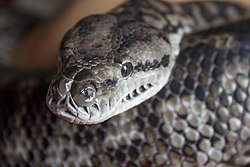| Morelia spilota metcalfei | |
|---|---|
 | |
| Scientific classification | |
| Kingdom: | Animalia |
| Phylum: | Chordata |
| Class: | Reptilia |
| Order: | Squamata |
| Suborder: | Serpentes |
| Family: | Pythonidae |
| Genus: | Morelia |
| Species: | |
| Subspecies: | M. s. metcalfei |
| Trinomial name | |
| Morelia spilota metcalfei Wells & Wellington, 1984 | |
 | |
| Range of M. s. spilota (in red) | |
| Synonyms | |
| |
The Morelia spilota metcalfei found in Australia, commonly known as the Murray-Darling carpet python. The pythons are non-venomous snakes that constrict their prey. They grow up to 2.7m (10 feet), but adults are usually around 2.4m (8 feet). [2] Colour varies depending on locality. Victorian Murray-Darlings are silver with solid black blotches and stripes; in New South Wales the silver becomes a light brown and the patterning has more of a black colour; South Australian MDs appear similar to those in New South Wales, though with patches of maroon. [3] These pythons are semi-arboreal, typically inhabiting rocky outcrops, dry woodlands, riverine forests and flood plains. [4] [5] The threats to the snakes are people and other snakes.[ citation needed ]



